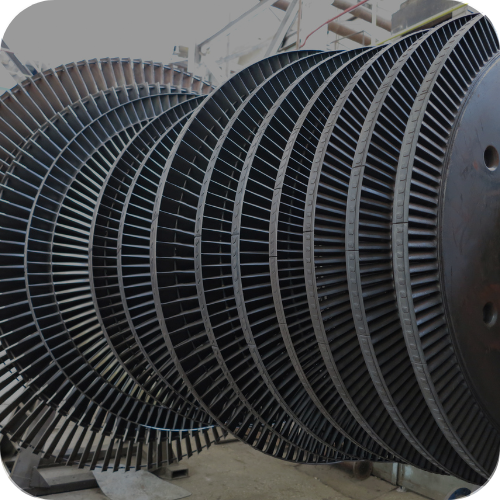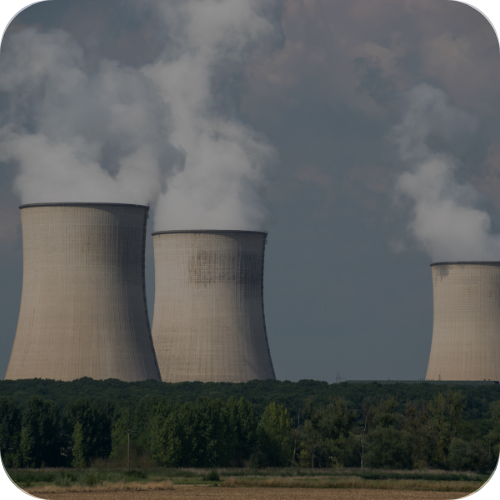Dx in Process Manufacturing
Industry Overview
In the rapidly evolving power generation sector, encompassing both thermal and renewable energies, the imperative to minimize operational expenditures while maximizing efficiency has never been more critical. Furthermore, the transition towards renewable energy source adds another layer of complexity to operational optimization, given the intermittent nature of resources like wind and solar power.

Dx Opportunities
Power generation sector with flexible operations demands for real time optimization to ensure the health and performance of assets across the site remain at the highest possible levels. With the scale of energy generation, the opportunity to optimize fuel, improve the efficiency of the critical assets based on the historical and real time data needs to be fulfilled. Tridiagonal excels in applying these technologies on a grand scale, enabling power generation entities to realize their full operational potential through enhanced efficiency, innovation, and a commitment to environmental responsibility.
Implementing the best of AI models to maximize the power generation potential through open loop forecasting algorithms. Predict the fuel consumption against actual fuel consumption with power generation potential. Optimize the water consumption in reheaters to cooling tower energy consumption reduction.
Optimization of coal consumption in boilers, Reheater spray optimization in boilers, steam loss monitoring in the plant wide network, Power generation prediction for solar and wind assets
Energy Management
Metal mining and cement industries are one of the major sources of global emissions. Nature of the industry demands for high consumption of natural resources and fuels including coal, water, air and others. Management of GHG contributors across the processing facilities including utilities is key for improving the overall energy efficiency of the operations. For a production facility, it is important to operate at the optimal level to ensure that overall energy, steam, water consumption per unit production is minimum as per the predictions. Tridiagonal solutions tailored frameworks enables the organizations to have a deeper and meaningful insights about energy KPIs across the facilities. Thes solutions are curated to deliver the best-in-class solution to bring about the visibility of various energy sources and sinks using the hybrid approach leveraging first principles and data driven techniques.

KPIs such as steam to fuel ratio is an important metric to allow the frameworks to identify the opportunities for optimization. Correlate the best possible fuel combination strategy with the predicted CV against the target steam production.
Electrical drives are one of the major energy consumers for these sectors. Tracking the energy of these drives through energy meters can help the manufacturers to plan and schedule the production ahead by 15-30 mins.
Industries have been seeing a big shift towards alternative fuels which include both solid and liquid wastes. Ensuring the same heat content is delivered by the AFR in comparison to traditional fuels is difficult to estimate. AI models can recommend the manufacturers with the required amount and combination of alternative fuels to meet the energy demand.
Track and monitor the steam, water and electricity consumption at equipment and site level operations. Predict the required amount of steam using first principles and benchmark it against the actual steam consumption. Track the overall steam economy across various unit operations and process across site, starting with Boilers to turbines and furnaces in processing facilities.
For more details on the use cases focusing on energy, steam, water and other resources please click here.
Detect the future unwanted failures due to unplanned downtime and overhauls for the critical rotating assets. Estimate the critical process parameters correlated with the failure modes in real time operations.
Failure prediction in HP turbines using chemical deposition, Tube failures in boilers, optimization of startup and shutdown operations, Performance monitoring of compressors/pumps using 1st principle models, soiling prediction in solar assets
Predictive maintenance
Improve the performance and availability of ESP, Cylone separators, Kiln refractory lines and cement mills. Maintaining the availability for the desired period of uptime is one of the most important tasks for the production to run continuously to meet the market requirements. Critical assets spans from compressors, ESPs, separators and furnaces. Unforeseen operating conditions makes it difficult for the operators to understand the dynamics around the health of the equipment. Several factors including deviations in KPIs to seasonality variations lead to unplanned downtimes in the critical assets. With our expertise in dealing with rotating assets, it has been made possible to leverage the physics augmented data driven techniques to track the anomalies and deviations in the assets which can cause the chances of failures. With the predictions organizations can see multiple benefits in planning the maintenance activities to reducing the overall inventory costs.

Air compressors are one of the most critical assets that ensure the production is met at their desired level of targets at minimum operating cost. Using this solution reliability team can predict the performance (Isentropic and polytropic) and health in real time. These modules help the team to predict the possibilities of failures with the deeper insights about the failure modes and prescriptions.
ESPs are essential in the metal industry for removing particulate matter from exhaust gases before they are released into the atmosphere. AI enabled predictive maintenance models can provide early indicators for anomalies in the ESPs which may result in unplanned downtimes leading to unwanted stoppages in the production
Predict the failures of bearing due to excessive vibrations leading to unplanned downtimes. AI models provides early indicators with the information of the critical components and the contributors dictating the failure modes.
Ball mills, crucial for grinding raw materials and clinker in cement production, demand high reliability and optimal performance to maintain continuous production. AI models enables the operators with the early signatures providing insights about the critical deviating parameters to prevent any bearing, misalignment or lubrication related issues.
Soft sensors for prediction of the lab parameters including the chemical and dissolved gas analysis. Estimate the parameters which are highly correlated with the quality variables to interpret and derive actionable insight for improving the life of the critical operations.
Dissolved gas analysis for transformers, Water quality prediction for efficient cooling tower operations, flue gas profile analysis at various operating scenarios
Predictive Quality
Quality management for various entities including fuel is important to produce energy at the desired level. Most of quality variables are recorded based on the lab sampling at certain low frequent intervals, which makes it difficult for the control room operators to take the real time corrective actions. With inferential modeling process operators can gain deeper insights about the set point control changes required for achieving the optimal quality specifications.

With several sources of coal, it is important to maintain the quality of the blend at a desired level to provide the optimal combustion source in the boiler operations. AI based smart inferentials can help the operators identify the best possible combination of coal and output blend quality.

DGA involve analysis of several hydrocarbon gases. The analysis is not possible in real time. AI can be leveraged to develop the sofsensor for each of the gas analysis to predict the values in real time.
Maintaining the water quality is important to prevent any scales or deposition in the downstream processing facilities. Using inferential modeling quality parameters such as PH, Chloride content, Oxygen demand can be predicted in real time aiding the operators to manage and maintain the water quality at the desired levels.
Multi-effect evaporators are important to concentrate the solvent to desired levels at optimal consumption of steam. Overall economy of steam depends on the steam consumed to production achieved with specified product concentration. AI predicts the concentration in real time at various operating conditions helping to minimize the iterations to resort at the right combination of input parameters.
Optimize the resources consumed per unit power generated using AI based models. Prediction of the heat rate in real-time to operate the assets at efficient conditions. Flexible operations allow for the operators to continuously identify the opportunities for optimization in real time operations.
PH spray optimization, Anomaly detection in Working oil temperature in boiler feedwater pump, Optimization of the feed make up water in cooling tower operations, Improving the efficiency of the solar and wind assets
Process optimization
Maintaining the product grade as per the desired quality specification and minimum energy consumption is important to reduce the overall cost of manufacturing. Minimize the grade transition period and product off-specifications through AI based prescriptive analytics. Operate at the maximum possible efficiency with optimal cycle time of heat in order to improve continuously. Optimize the cycle time of the processes through AI-based optimization toolbox. Leverage the AI based simulators to continuously identify the opportunities to optimize the control strategy to meet the desired product specifications at minimum operating costs.

AI model can help to determine the optimal addition of Flux materials to eliminate the impurities generated during the production of Liquid Steel. AI models prescribe the manufacturers to optimize the addition of the external additives to reduce the overall cost of production and ensure product specifications are met during each heat.
Sequential AI models can predict the optimal level of ALF3 required to maintain the bath temperature and excess ALF within the specifications. This model can help the operators to minimize the energy consumption and maintain the quality requirements of the hot liquid aluminum from the smelters.
Rotary kiln operations are critical to remain stable under the varied conditions of fuel, feed and seasonality fluctuations. AI based models can correlate the impact of these factors with the burning zone temperature. Prescriptions can help to maintain the BZT under several fluctuating influences
Analysis and interpretation of the unstructured reports in correlation with the time series parameters to discover the hidden patterns. Generative AI based chatbot for easy access of the unstructured documents generated on daily basis.
Interpretation of RCA reports for improving the reliability of the critical assets, Alarm report analytics, Analysis of historical coal consumption trends using its quality reports
Generative AI
More than a quarter of data remains unused as it becomes difficult to access and interpret them due to its unstructured and non-standard formats. Documentation spans from raw materials information, production reports to quality and compliance records. Generative AI can be leveraged to automate the interpretation of the information using the zero shot and few shots LLMs to interpret and analyze the unstructured dimensions. Integrate the interpretation from quality reports, product compliance report, incident reports and many others for improving the productivity and gaining deeper insights about the operational dynamics.

In order to continuously improve the shop floor productivity, it is important to extract many unstructured information such as visual and physical characteristics of the product. Usually, such information are available in siloed unstructured documents. LLM models can be leveraged to extract and derive meaningful insights from these documents to provide the intelligence to the operations team
Alarms are critical to be monitored and categorized in several priorities. With the LLMs unstructured alarm reports can be segregated based on its criticality and frequency. These models can augment advanced analysis intelligence to estimate and correlate the information with process parameters
Improve the interpretability with meaningful insights derived from the historical RCA reports. Real time anomalies can be correlated with the historically similar events with the added intelligence about the indicators and corrective actions.
An Operator Training Simulator (OTS) is a high fidelity, computer based system that enhances operator skills, safety, and efficiency in complex industrial environments by providing a realistic, risk-free training environment. It ensures operators are well-prepared for both routine and emergency situations, contributing significantly to the overall success and safety of the organization.
Realistic Training Environments, Risk Free Simulations, Scenario-Based Learning, Performance Tracking, Knowledge Retention, Regulatory Compliance are the highlights of OTS.
Operator Training Simulator (OTS)
In the intricate and high-stakes world of industrial operations, ensuring the skill and readiness of operators is essential. An Operator Training Simulator (OTS) is a crucial tool in this realm, offering numerous benefits that enhance safety, efficiency, and overall operational success. Key advantages of an OTS is its ability to provide a realistic yet risk-free training environment. Operators can engage with simulations of actual industrial systems, practicing routine tasks and responding to emergency situations. This hands-on experience is vital for developing the skills needed to handle real-world operations confidently. By simulating hazardous scenarios, operators learn to manage potential crises without endangering personnel, equipment, or the environment.
.webp?width=350&height=230&name=Operator%20Training%20Simulator%20(OTS).webp)
.png?width=152&height=164&name=Dynamic%20Simulation%20(Operator%20training%20simulation).png)
An OTS provides comprehensive scenario-based training, encompassing normal operations, startups, shutdowns, and emergency responses. This diverse array of training scenarios ensures operators are well-prepared for any situation they may face. The opportunity to repeatedly practice these scenarios helps ingrained proper procedures and quick decision-making skills, significantly reducing the likelihood of errors during actual operations.
A key feature of an OTS is its ability to continuously track and evaluate operator performance. By providing detailed feedback and pinpointing areas for improvement, it fosters a culture of continuous learning and development. This ongoing assessment ensures operators maintain high proficiency levels and can effectively adapt to new challenges.
Safety is paramount in industrial operations, and an OTS significantly raises safety standards. Well-trained operators are less prone to errors that could result in accidents, thereby safeguarding both personnel and equipment. Additionally, by minimizing operational mistakes and unplanned downtime, an OTS enhances overall efficiency, leading to more streamlined and productive operations.
Implementing an OTS is financially advantageous, as it reduces errors and downtime, leading to substantial cost savings. Additionally, an OTS ensures that operators receive consistent and comprehensive training, aiding organizations in meeting industry regulations and standards. This thorough training can be documented and audited, facilitating compliance.
Use Cases
Despite of the ever-growing market and dynamic changes digital is still harnessed to catalyse the solutions for various industrial challenges across the value chain. Find below the list of use cases specific to shop floor interests addressing various challenges encountered within the power generation sector.
Accelerate your Dx transformation projects with Smart Apps and Time-to-value (TTV) program
Integrate ready-to-deploy smart apps with your existing IT-OT infrastructure and scale across plants.







- Smart Apps
- TTV A-33 Program
Tridiagonal Solutions launches ‘Process optimization framework’ for manufacturing industry. We optimize processes for energy, efficiency, quality using cutting-edge technology and engineering expertise. From custom column design to process intensification, we're driving innovation for a sustainable future.
Leveraging these frameworks allows the industry to implement the ML models at scale.
Time to Value program leverages advanced scalability frameworks to deliver superior analytics solutions to manufacturing industries. Designed for rapid implementation, our program ensures larger delivery with unparalleled speed and efficiency. By utilizing scalability frameworks, we significantly reduce the time and cost associated for standard approaches. and accelerates deployment, allowing manufacturers to quickly gain insights and drive improvements in their operations. With our program, clients benefit from faster, data-driven decision-making, enhanced productivity, and a swift return on investment, making it the optimal choice for modern manufacturing analytics projects.
Why Tridiagonal?
Team having exposure and expertise of developing scalable solutions across multiple platforms.
Looking for Trusted Partner for executing your programs?
We bring together unparalleled expertise with combination of skillsets and technology to address your digital, computational and testing needs








